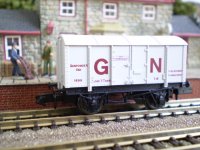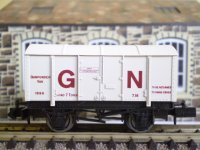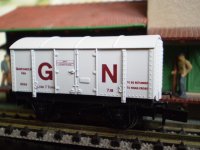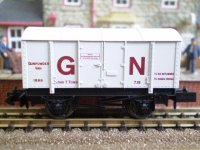Back in the golden reign of Queen Victoria, long before governments thought that playing with trains
was part of their remit, the railways of Britain were run by a colourful selection of independent companies.
Some were only small but some were mighty, and one of the mightiest of them all was the proud Great
Northern Railway. Its visionary chairman Edmund Denison hired engineer William Cubitt to build a main
line from London to York, and by 1852 it was up and running. As their network spread, passengers could travel
direct from the GNR's new London terminus at Kings Cross to all the main towns and cities of Yorkshire.
Denison retired in 1864 to be succeeded by Henry Oakley, who commissioned Patrick Stirling to design a new
generation of passenger locomotives, and by the 1870s the GNR's express schedules were amongst the fastest
in the world. But like all railways, the passenger trains made the headlines but the goods trains made the
profits, and the GNR had a vast fleet of wagons to carry all kinds of freight imaginable. Most of these were
humble wooden-bodied coal wagons, making the GNR and its shareholders wealthy by carrying trainloads of
black diamonds south from the pits of Yorkshire to the hearths and furnaces of London. But
not everything could be carried in a coal truck, and more specialised loads needed special vehicles to
transport them. Our model is a gunpowder van, used for carrying explosives and munitions, and it goes
without saying that these loads needed to be handled very carefully indeed. In an era where wood was the
standard material for passenger coaches as well as goods wagons, these vans were made of steel.
Inside they were lined with copper, so that a railwayman's hobnailed boots couldn't strike a spark.
Vehicles with hazardous loads were usually painted up in very distinctive colours to make their presence
obvious, and the GNR reversed their normal goods livery to paint gunpowder vans white with red-oxide
lettering. These wagons would have been a familiar sight across the GNR network, which at its height
extended from Liverpool to the Norfolk coast, thanks to joint ventures with neighbouring companies.
During the dark days of the First World War they were even run attached to passenger trains,
incredible though this may seem in our modern Health and Safety world. In the post-war Grouping of
1923, the GNR was absorbed into the newly-created London and North Eastern Railway, but their
wagons would still have carried the old GN colours for a good few years before the LNER got round to
repainting them. And of course, on today's heritage railways the liveries of another era run again.
Bring some pre-grouping style to your layout with our GNR gunpowder van.
More information on the GNR can be found on the Great Northern Railway Society's website at
www.gnrs.150m.com
This wagon is produced in association with the Going Loco model shop of Wakefield,
and is also available for purchase from their retail premises in Potovens Lane or from
their stand at exhibitions.
|




